
Marcus Hanke
[PuristSPro Moderator]
11515

Ulysse Nardin presents the InnoVision concept watch
Ulysse Nardin
InnoVision
InnoVision
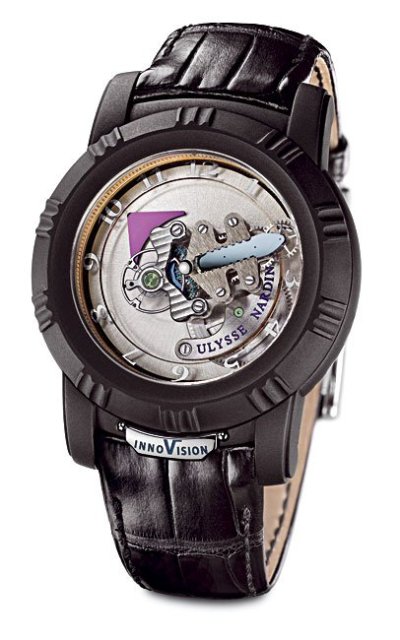
10 technological innovations united in one watch perfectly sum up Ulysse Nardin’s vision on the future of mechanical watchmaking.
Pioneering.
Ulysse Nardin has presented quite a number of “World’s Firsts“ in the past years, and many of them have used the „Freak“ as a showcase.
- The “Freak“ was the first watch with a silicium escapement. It was commercialized in 2001.
- Some Freak prototypes housed the first hairspring made of polycrystalline diamond which showed astonishing elasticity.
- The “Dual Ulysse“ escapement with parts made of nickel-phosphor (NiP) and silicium (2005)
- The first watch with an escapement made of polycrystalline diamond was commercialized in 2005
- Escapement components made of silicium can be used as skeletons to “grow” on them polycrystalline diamonds
The succession of “Freak” models illustrates the continuous technological developments at Ulysse Nardin!
An Evolution in Technology.
For many decades and till today movement components are being machined out of brass, steel and rubies and during this long period of technological stability traditional manufacturers have perfected the processes and their skills almost to perfection.
Ulysse Nardin has analyzed new technologies used in other industries and adapted them to the specific requirements for making high quality movement components. After the decision was taken to make our own in-house movements we studied the materials, technologies and scientific processes used in other micro-technical industries.
It soon became clear that manufacturing processes incorporating selective photolithography are the technologies to opt for.
Ulysse Nardin was determined to invest in technologies and materials of the future, pioneering new processes and taking an active role in the development of our industry. By mastering these new techniques and technologies, we secured for the company a future coupled with some independence which is of strategic importance.
“DRIE“ (Deep Reactive Ion Etching) and „LIGA“ (lithography, electroplating and molding) technologies are both completely new solutions to design and produce watch movement components of superior performance. These technologies offer possibilities which seemed unthinkable a few years ago.
Silicium escapements - and what else?
The excellent “dry” friction coefficient of silicium works not only on silicium, but also on steel.
Let’s be creative: Let’s use the new technologies to produce components in a completely new way and exploit the new possibilities to their full extent.
What if we combined the three positive characteristics of silicium: high flexibility, low friction and perfect engineering precision?
All three considerations are part of our vision and are actually incorporated in our concept watch ”InnoVision”.
Lubrification free mechanical movements – no oil, no solid lubrification or coatings.
Many colleagues and competitors have been working on this objective for decades.
A movement working literally forever, not requiring any maintenance at all, must be every watch engineer’s dream.
Ulysse Nardin is not alone in the pursuit of a solution to this problem, and we appreciate every step taken in this direction – including those of our competitors. The approach to apply a durable dry coating of a non-displacing lubricant is very interesting, and we take our hat off to the engineers of Jaeger-LeCoultre, also for their intensive research on the oscillator to improve precision.
- Nivarox presented “Lubrifar” in the early 1970’s, a layer of molybdenum disulfide (MoS2). The use of MoS2 has greatly progressed since then, and many other kinds of lubrifying coatings (layers) have been developed and sometimes even put into use.
- Tissot’s Astrolon created a sensation with its plastic mobiles (Polyoxymethylene) directly running on steel pins with no lubrication at all.
The solution proposed by Ulysse Nardin differs radically from all others:
We combine the precision of silicium etching (DRIE), the precision and mechanical resistance of nickel (LIGA), the elastic properties of silicium and its low dry friction coefficient with the fabulous potential of the multi level processing technology developed by Sigatec. Low friction without lubrication is just one aspect in our „InnoVision“.
Barrel on ball bearings.
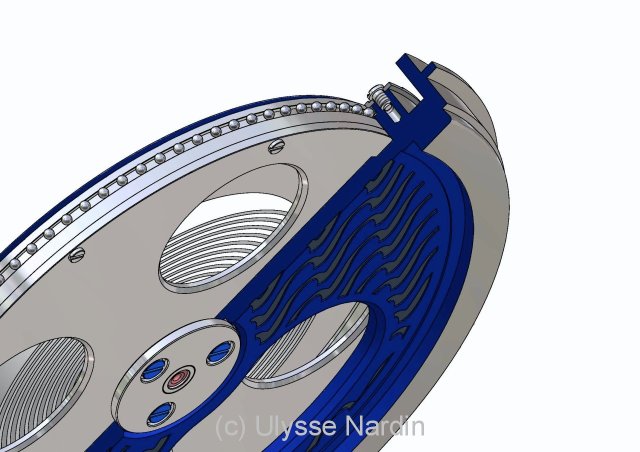
Innovation 1: Mainspring barrel on ball bearings
Of course this is no exclusivity; ball bearings are widely used in winding rotors for instance. Ulysse Nardin has been using ball bearings in the Astrolabium since 1985. If the materials are carefully chosen in correspondence to the turnings speeds and pressures involved, there is no need for lubrication.
„Dual Ulysse“ escapement.
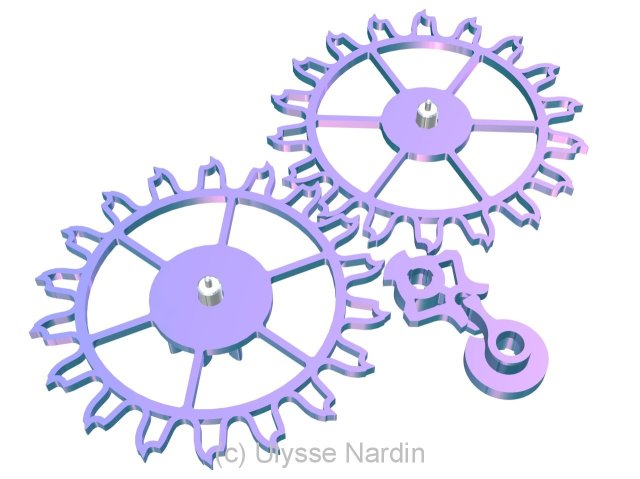
Innovation 2: Dual Ulysse escapement
Silicium bearings.
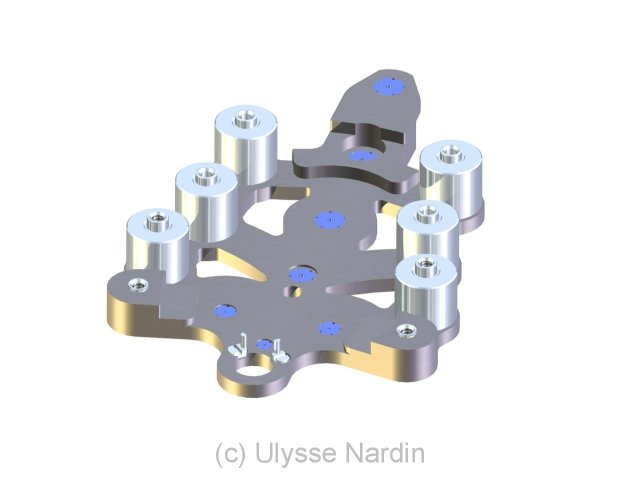
Innovation 3: Silicium bearings
We could have substituted the rubies with plastic compounds (POM), ceramics or bronze. We could have coated bearing surfaces by means of PVD or CVD or apply a non-evaporative coat of lubricant. Some competitors have done so, quite successfully. At Ulysse Nardin we decided to choose the direct contact of stainless steel on silicium oxide.
DRIE precision and low friction advantages put together.
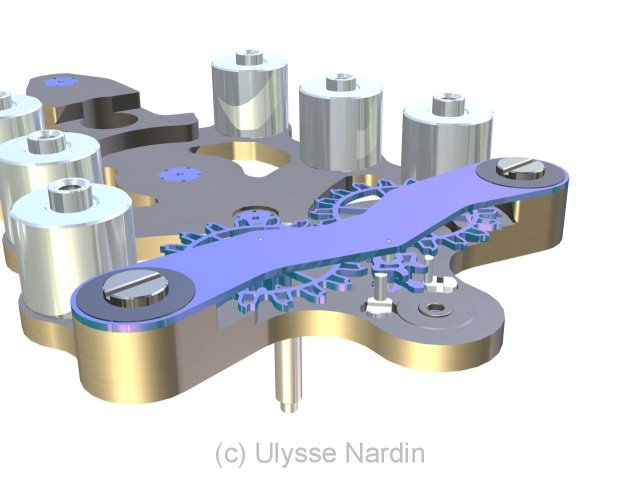
Innovation 4: Ultra-high precision in shaping plates and bridges
This world premiere is of great importance for the whole industry, because in the near future this technology will no doubt make its way into other watches. The precision of bearing holes in a monolithic silicium bridge is five times more accurate than in a conventionally drilled brass bridge set with jewels. Another advantage: Due to the lack of an oil groove necessitating a relatively huge circumference of the jewel, the designer can put his bearing holes much closer to the exterior of a bridge.
Another step ahead: How to reinforce a silicium bridge.
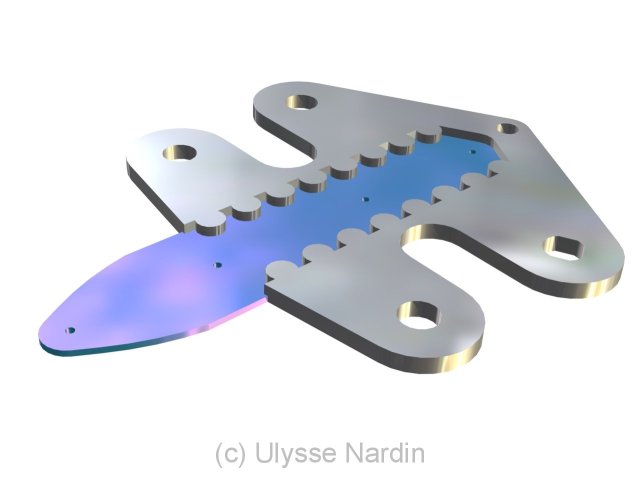
Innovation 5: Composite bridge
In cooperation with Sigatec and Mimotec Ulysse Nardin has developed a better solution: A bridge composed of two materials, using DRIE and LIGA processes in a unique new way.
A precisely etched silicon wafer serves as the initial “skeleton” for a hard and resistant nickel structure, made with the LIGA process. The part made with this technique benefits from the best characteristics of each material and process:
- the photolithographic process stands for high precision.
- silicon stands for a good friction coefficient.
- nickel stands for tough mechanical properties.
This “World’s First” is a good example for the successful combination of positive properties of different materials without their shortcomings.
Exploiting the elasticity of silicium.
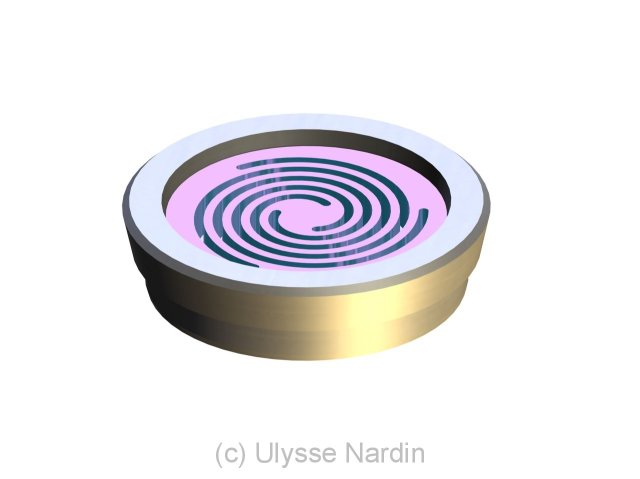
Innovation 6: Revolutionary new one-piece silicium shock absorbing system
A classic shock absorbing system consists of five micro elements.
In our silicium shock absorber a single monolithic element takes over the tasks of the spring, bearing and endstone.
It is a world premiere of an extraordinary simplification of a complex micro-system thanks to a new technology and the use of new materials.
The end of the balance staff turns directly in a cavity in the middle of the silicium disc. The circumference of this disc is shaped like a spring so it can deflect and absorb an impact. The disc returns to its initial position with no friction at all: it just springs back into shape. In a classical shock absorbing system the bearing jewel has to overcome considerable friction to return to its initial position in a conical or flat seat.
It is known that the elastic properties of silicium can also be used in a hairspring.
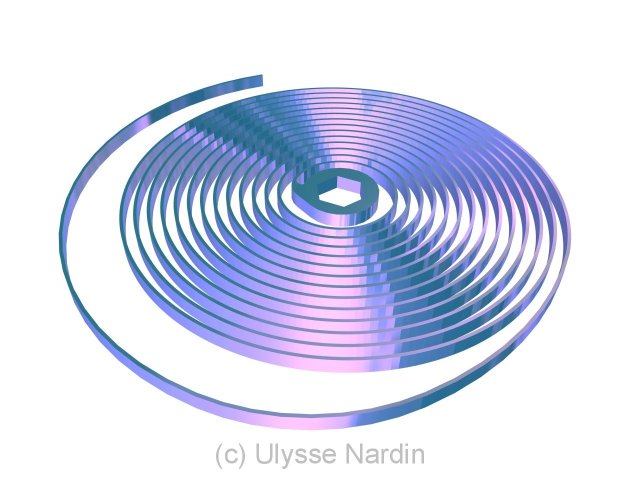
Innovation 7: Silicium hairspring
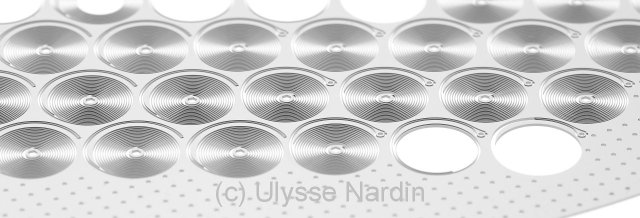
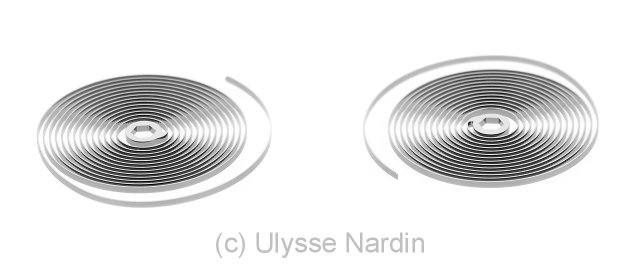
The silicium hairspring is an excellent solution and we have the know-how to produce it.
New production processes.
While silicium processing in the field of micro-electronics has evolved considerably over the past 50 years, developments in the field of micro-mechanics have only just begun to gain momentum.
Sigatec is very active in developing and perfecting a new process enabling the production of micro-components in one piece, where traditional manufacturing methods require several components to make the final piece:
Roller and Pin.
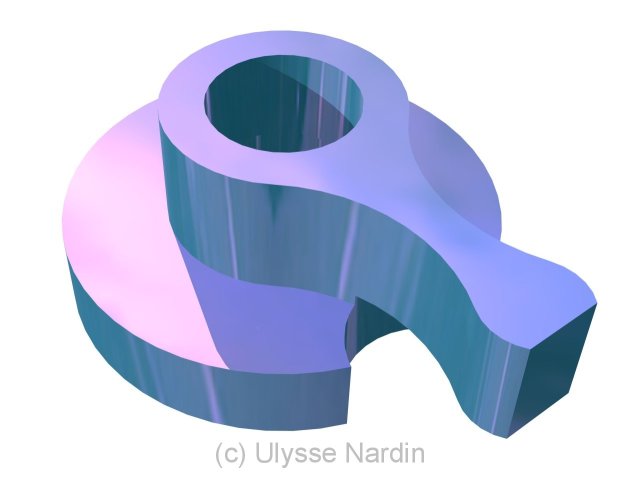
Innovation 8: One-piece Roller and Pin
This world premiere is good news for the watch industry - especially for those companies that are unable to produce roller plates in the traditional way.
The horns of the stopper fork and the security pin in the “Dual Ulysse” escapement.
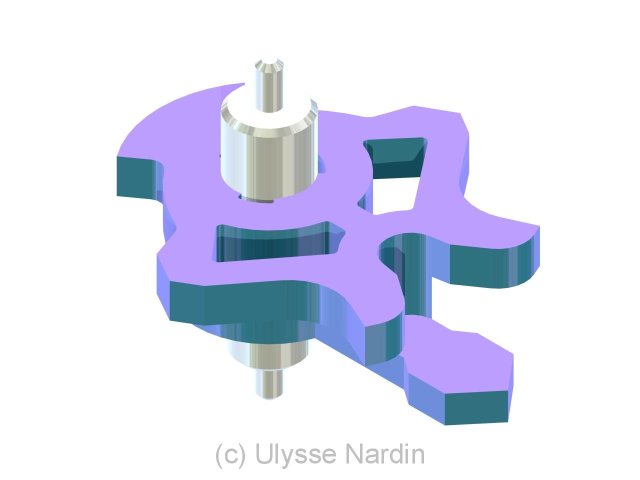
Innovation 9: One-piece horns and pin
As with the anchor of the Swiss anchor escapement the alignment of the security pin is crucial for a good and trouble-free function. Perfect alignment is ensured by the DRIE etching process; the only source for misalignment lies in the positioning of the etching masks. No finishing touches are necessary.
This world premiere is very important for the general recognition of silicium as an ideal material to manufacture escapement components.
The two level process developed by Sigatec is the third example in the evolution of ion etching. Ulysse Nardin fitted its InnoVision concept watch with escapement wheel and pinion produced in one piece.
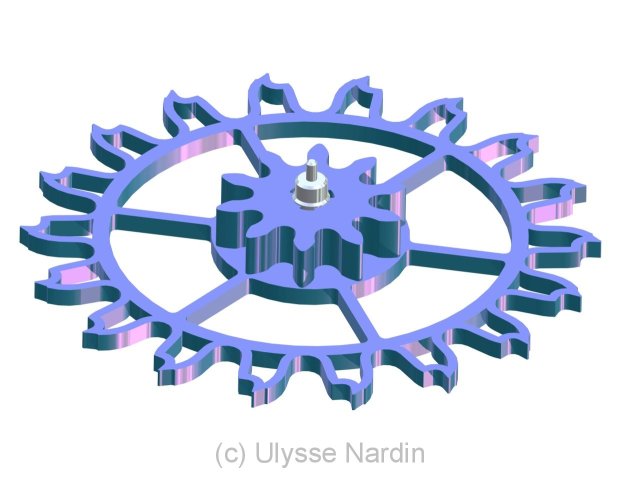
Innovation 10: Two-level process in production of escapement wheel with pinion
Gears in watch movements are composed of a brass wheel with a pressed-in or riveted steel staff with a pinion. Some mechanisms even require specific angular positioning of the wheel in relation to the pinion. Thus producing a wheel-pinion unit in one piece is a big advantage. There is no necessity for the Freak to be fitted with such a wheel-pinion unit, we did so simply to demonstrate this innovative device. It will no doubt inspire designers of mechanical movements all over the world.
The concept watch „InnoVision“ of ULYSSE NARDIN .
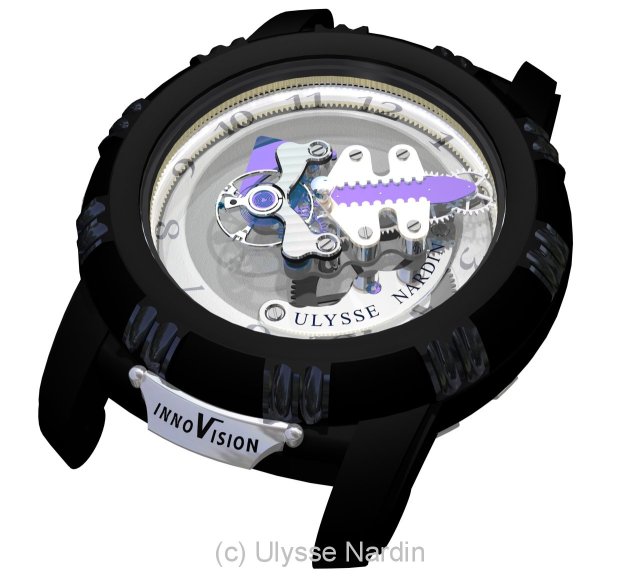
The technologies and materials used in the „InnoVision“ are neither marketing gimmicks nor “art for art’s sake”. Instead they have a fundamental technical reason:
- not only to overcome lubrication
- not only to benefit from the precision of the process
- not only because of the simplification of the process due to double-sided or two-level approach to make a component.
- not only for the sake of combining LIGA and DRIE technologies
- but for all of the aforementioned reasons.
Mechanical watchmaking is alive and booming: Several colleagues are developing new concepts, and after decades of copying the “Old Masters” imagination is back reveling in innovation. ULYSSE NARDIN no doubt contributed its share to the evolution in mechanical timepieces.
ULYSSE NARDIN will continue to opt for modern technologies to improve its products.
We are very optimistic about these innovations as the initial tests produced extremely positive results – way above expectations. All 10 in novations work simultaneously in our “InnoVision” and make it a perfect example of the dynamic forces at work in the mechanical watch industry.
This message has been edited by Marcus Hanke on 2007-08-30 13:08:17
Locked
login to reply